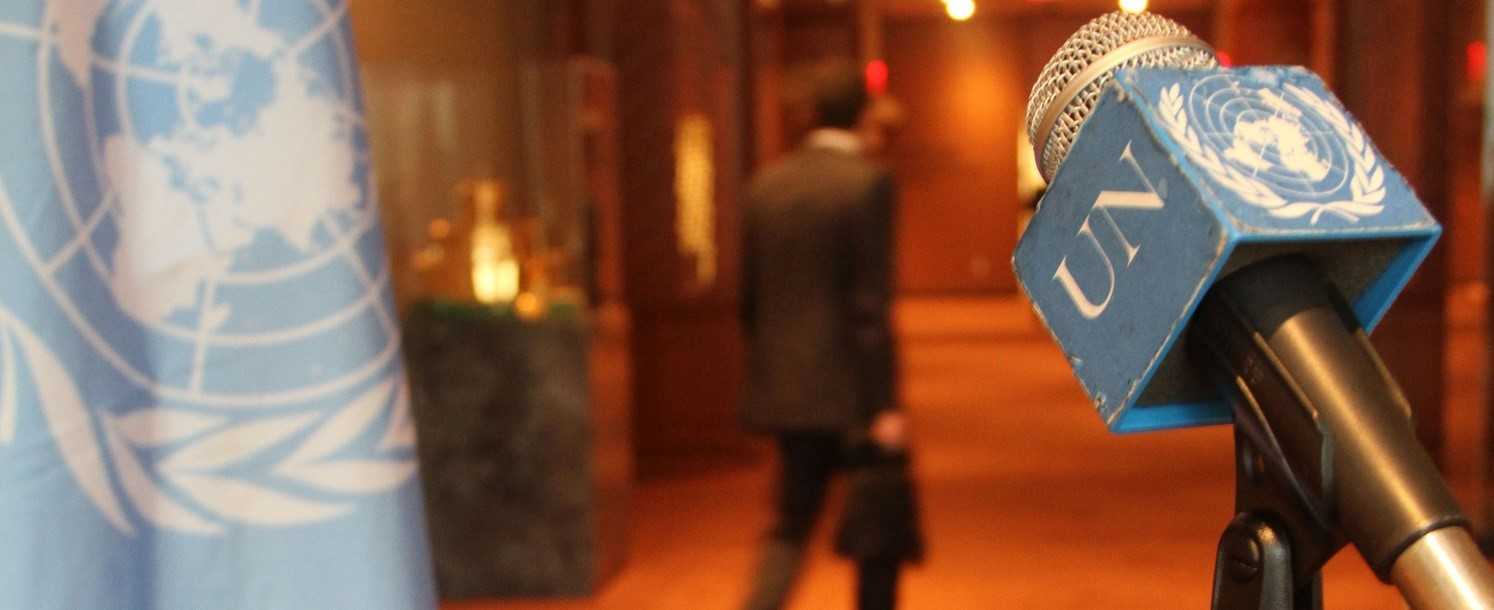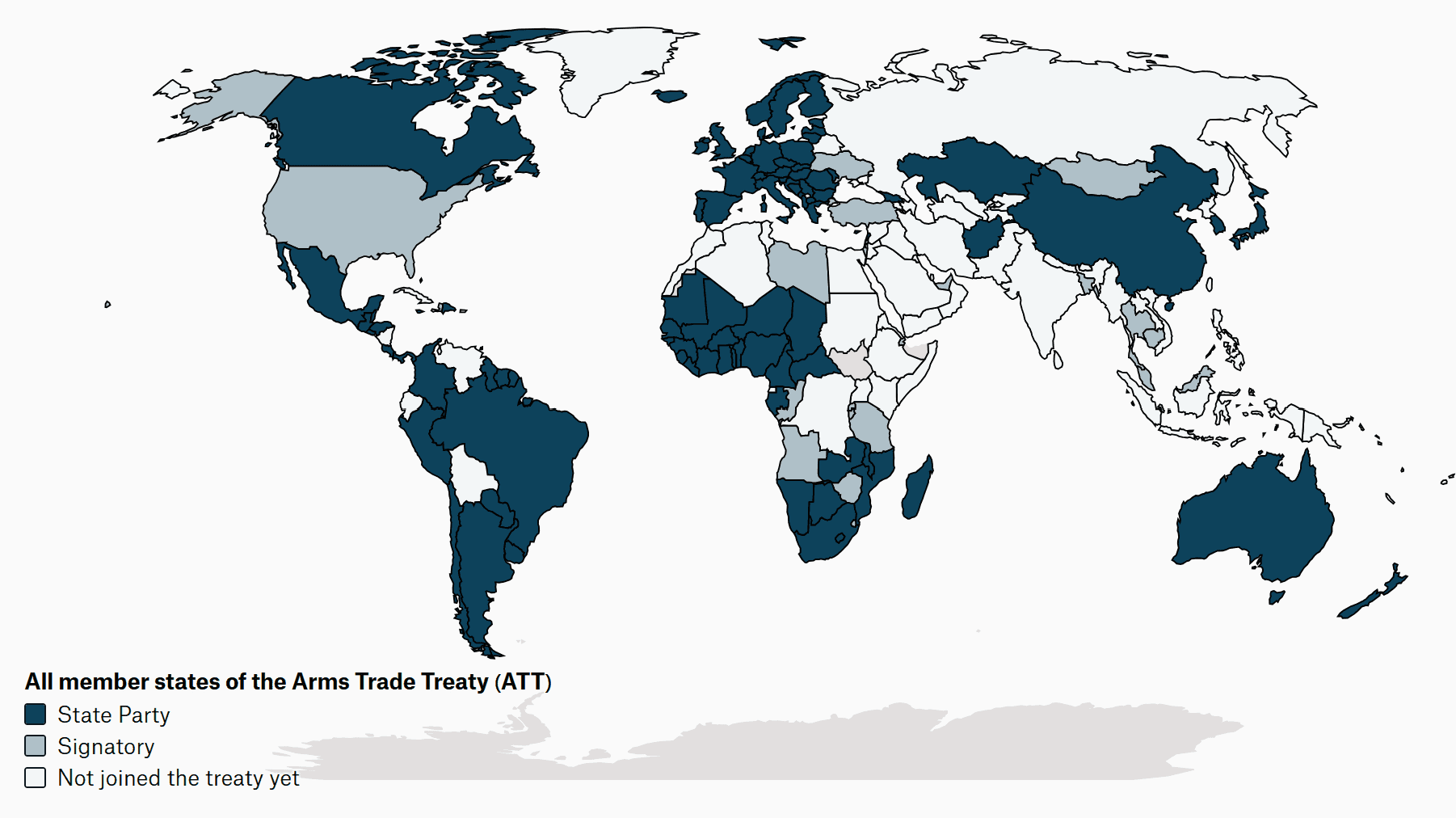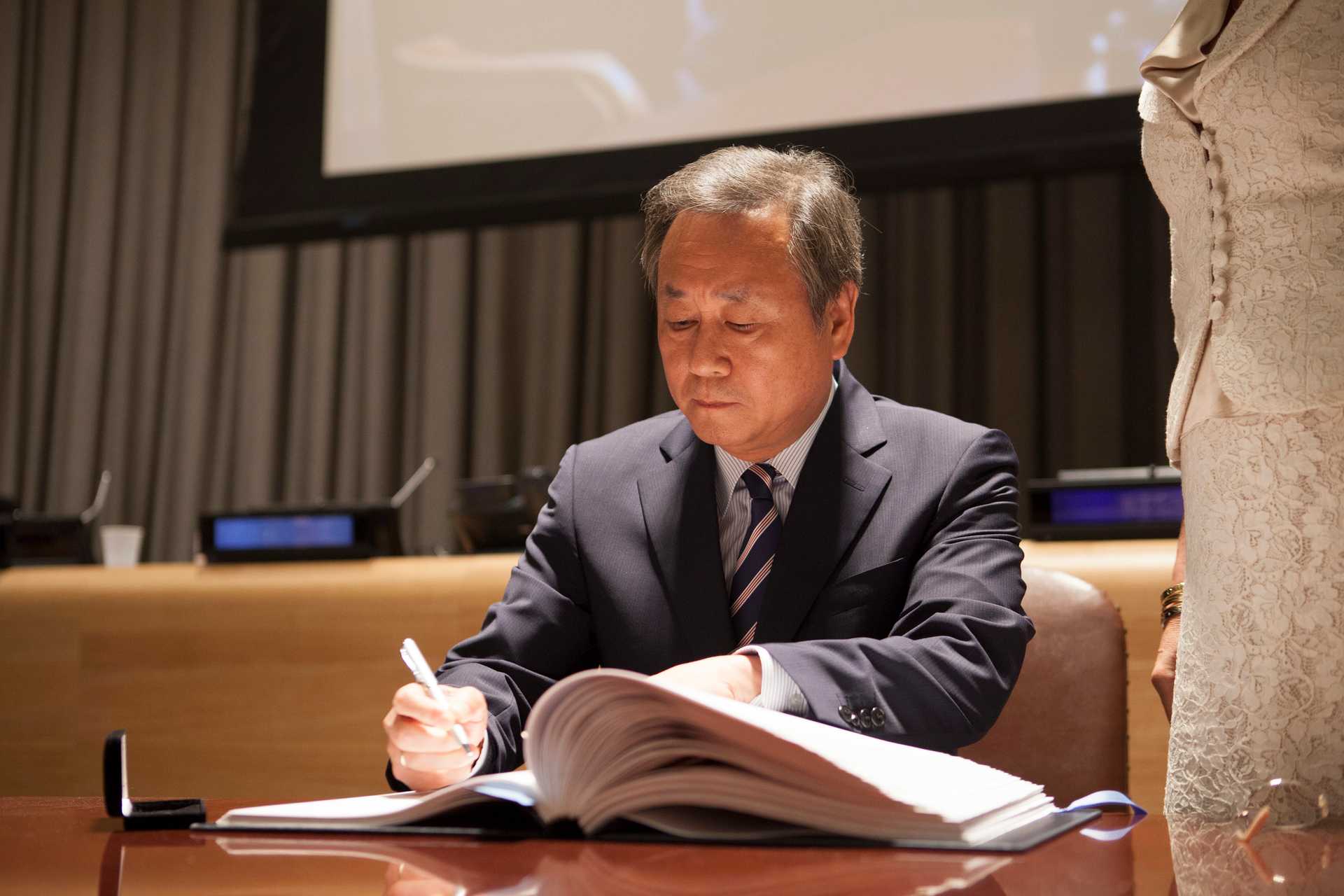
Negotiating the ATT
The Arms Trade Treaty (ATT) is the result of almost 20 years of diplomacy and advocacy.
- 1997
Early Initiatives
Former Nobel Prize laureates drafted an International Code of Conduct on Arms Transfers, laying the groundwork for what would eventually become the Arms Trade Treaty (ATT).
- 2001
Draft Framework Convention
A Draft Framework Convention on International Arms Transfers was circulated at the UN Small Arms and Light Weapons (SALW) Conference, calling for a universal, legally binding agreement governing arms transfers.
- 2006
UN Resolution Initiation
The UN Resolution that launched the development process of the ATT was initiated by the United Kingdom, Australia, Argentina, Costa Rica, Finland, Kenya, and Japan.
- 2009
Resolution 64/48
The UN adopted Resolution 64/48, convening a conference in 2012 to negotiate the ATT.
- 2012
Negotiation Challenges
During negotiations, diplomats failed to agree on an acceptable text. Key disagreements included the treaty’s scope (e.g., inclusion of ammunition), human rights assessment criteria, prohibition of exports to non-state actors, and concerns about member states’ export restrictions.
- April 2013
Arms Trade Treaty adopted
The General Assembly of the United Nations adopted the Arms Trade Treaty, the first global instrument regulating the international trade in conventional arms.
Despite the challenge of getting the majority of member states to vote for it, the ATT became a landmark treaty in regulating the international arms trade. It also set a new precedent as it became the first treaty to include provisions for preventing gender-based violence (GBV), requiring exporting states to consider the risk of arms being used in committing serious acts of GBV. Adding a reference to gender was a central part of civil society advocacy during the negotiations. Such efforts faced significant resistance from a few states, particularly the Holy See, which requested the term “violence against women” be used instead of GBV. With the help of the supporting states, however, the prevention of GBV was added as a legally binding criterion to the ATT. Almost a decade since it entered into force, the ATT gender-based violence provision applies mostly in situations of serious violations of international law and human rights, less so in cases of GBV in domestic contexts.
Elements and status of the ATT
The Arms Trade Treaty came into force in December 2014.
Arms Trade Treaty (ATT)
The Arms Trade Treaty regulates the international trade in conventional arms and aims to prevent illicit trading and diversions.
Current Adoption
Data: UNODA Treaties Database
Fact sheet: Arms Trade Treaty (ATT)
The Arms Trade Treaty focuses on export, but also includes a number of provisions on import, transit or transshipment, and brokering. The ATT obliges signatories to control arms export at the national level. It does not apply to the international movement of conventional arms by or on behalf of a state party for its own use, provided that the conventional arms remain under the ownership of that state party.
The ATT applies to the following eight categories of conventional arms:
- Battle tanks
- Armoured combat vehicles
- Large-calibre artillery systems
- Combat aircraft
- Attack helicopters
- Warships
- Missiles and missile launchers
- Small arms and light weapons
As already mentioned, the ATT has two main objectives:
- To establish the highest possible common international standards for regulating or improving the regulation of the international trade in conventional arms.
- To prevent and eradicate the illicit trade in conventional arms and prevent their diversion.
Objective 1: Establishing common international standards for regulating the international trade in conventional arms
- National arms export control system
- National control list on conventional arms (e.g. small arms and light weapons, battle tanks, combat aircrafts, attack helicopters)
- National export control system for munition and other components
Objective 2: Combatting the illicit arms trade and preventing the diversion of these weapons
- Record-keeping, e.g. on export authorisations granted
- Provisions on international cooperation and information exchange, e.g. sharing information on illicit activities and actors or providing assistance with regard to stockpile management or the implementation of legislation
- Requirement to take appropriate measures to address diversion
Prohibitions A state party shall not authorise any transfer of conventional arms if:
- this would violate its obligations under measures adopted by the United Nations Security Council acting under Chapter VII of the Charter of the United Nations, in particular arms embargoes;
- this would violate its relevant international obligations under international agreements to which it is a party, in particular those relating to the transfer of, or illicit trafficking in conventional arms; or
- the state knows that the items would be used in committing genocide, crimes against humanity, grave breaches of the Geneva Conventions of 1949 or other specified war crimes.
Assessment criteria
Set assessment criteria on the risk the exported weapons pose in the following areas:
- Contributing to or undermining peace and security
- Potentially being used to commit or facilitate terrorism, organised crime or a serious violation of international law
- Being used to commit or facilitate serious acts of gender-based violence or serious acts of violence against women and children
Other provisions
- States parties can consider mitigation measures
- States parties shall take measures to prevent diversion
- States parties are required to keep records of export authorisations (G) or actual exports
- States parties must submit annual report on authorised or actual imports and exports to the Secretariat
- States parties are encouraged to provide international cooperation and assistance for implementation of the Arms Trade Treaty
As of February 2025, the ATT comprises 116 states parties, 26 signatories that are not yet states parties, and 53 states that have not yet joined the Treaty.

The position of the EU towards the ATT
The EU has played a supportive role in the development of the ATT.
In 2005, the Council of the EU explicitly expressed its support for an Arms Trade Treaty for the first time. The Council agreed that the United Nations was the only forum that could deliver a truly universal instrument and the EU expressed its commitment to play an active role in this process.
Council conclusions calling for a legally binding Arms Trade Treaty were adopted on 11 December 2006 and 18 June 2007.
The representatives from the Council, the European Commission, the European External Action Service (EEAS) and the Delegation of the EU at the UN cooperated closely during the process leading up to the final approval of the Arms Trade Treaty.
- The European Commission and the EEAS analysed the text proposals and supported member states in defining their positions.
- The concern of the Commission was to make sure that the language of the Treaty would not infringe on EU legislation.
- The EEAS coordinated consultations with member states in order to agree on common positions during the negotiations.
Adopting common positions was not an easy task and the EEAS encountered several difficulties in streamlining national concerns during the negotiations. However, the EU managed to present strong positions in the UN debate, for example that the consequences of the assessment of licence applications according to specific criteria should be clear and that criteria on corruption and sustainable development should be adopted. On other issues, such as the inclusion of civilian firearms, no agreement was reached among EU member states.
While the EU has been an active participant in the negotiations, it did not become party to the ATT (as is the case for the UN Firearms Protocol). However, all EU member states are parties to the ATT. In addition, the EU supports the implementation of the Treaty.
In 2021, for example, the EU adopted an outreach programme with a budget of 3.5 million euros to assist non-EU countries in strengthening their arms transfer systems in line with the requirements of the ATT.
With the aim of effective implementation and universalisation of the ATT, the EU supported activities of the ATT secretariat with a budget of 1.4 million euros (in 2021) and 1.3 million euros (in 2023).
